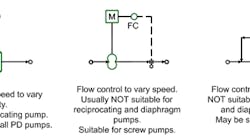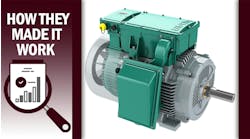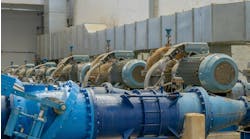Positive displacement (PD) pumps aren’t as common as centrifugal pumps at most plants. So, engineers typically are less familiar with how to control the flow of these pumps. Yet, many applications of PD pumps may benefit from flow control — e.g., direct control to meet process objectives or a cascade from level, temperature or other control loops.
Flow control on most centrifugal pumps involves varying the discharge pressure to alter the pump flow rate. A control valve supplies the variable pressure drop for the system. As long as the pump has a continuously rising head to zero flow, this system usually works dependably.
In contrast, changing flow resistance on a PD pump doesn’t vary the flow rate. In an ideal PD pump with incompressible fluids the flow rate is independent of both the suction and discharge pressures. Real pumps may vary from the ideal due to internal leakage. A control valve on a PD pump doesn’t control the flow rate. A control valve on a PD pump discharge controls the discharge pressure.
Controls for PD pump flow rates must take one of three approaches. First, modify the pump so that each stroke (reciprocating or diaphragm) moves a different amount of flow. Second, alter the speed of the pump. Third, use a recycle stream and change the amount of recycle.
Except for small metering pumps, varying the volume per stroke generally is mechanically complex and expensive. So, flow control in process applications usually involves either altering the pump speed or using recycle. Recycle may be either external or internal or both.
A PD pump normally runs at a slower speed than a standard motor. Therefore, a mechanical connection — such as a hydraulic torque converter, hydroviscous drive or eddy-current coupling — links the motor to the pump. All these can vary the pump speed at constant motor speed. In addition, today’s reliable variable frequency drives enable changing motor speed when using belt drives and gearboxes.
[javascriptSnippet ]
Figure 1 illustrates three basic methods to control PD pumps. Two involve varying motor speed and the other uses recycle.
Figure 1. Altering flow of a PD pump requires changing motor speed or the amount of recycle.
In the first method (left), an operator sets the pump speed manually. Flow isn’t directly measured. Instead, the operator uses a table of speeds versus flow rates for that service when setting the pump speed. If the control is part of a larger system, some upstream or downstream condition may be measured — and the speed then is varied directly to meet other targets, often a vessel level or temperature. In cases with a cascade to flow, the system inventory provides a cushion to smooth out the effects of uneven flow from the pumps. This system suits nearly all PD pumps, including reciprocating, diaphragm, gear, lobe, screw and progressive cavity types.
The second method involves measuring the flow rate downstream of the pump. The flow controller varies pump speed. This system often isn’t suitable for reciprocating and diaphragm pumps because their strokes cause flow surges that may make stable flow metering difficult. However, the system works well with pumps that have a continuous flow pattern such as gear, screw and progressive cavity types.
The third method varies the net forward flow of the pump via an external recycle loop. This most closely resembles flow control of a centrifugal pump. The recycle valve opens to allow flow to return to the pump suction. Downstream pressure defines the available pressure drop for the control valve. The recycle rate will change based on the pump differential pressure and the control valve opening. This method works best for systems with a high pressure rise and a constant downstream pressure, e.g., pumping from makeup tanks into a high-pressure process system.
The recycle system works well with screw, gear and progressive cavity pumps. It is acceptable for most vane pumps. However, don’t use the method for cyclic pumps such as reciprocating or diaphragm ones; rapidly changing outlet velocities easily can cause problems with cyclic pump inlet-head requirements.
Flow control of a PD pump can be very successful. Just remember to take into account the differences with centrifugal pumps and ensure the control system works correctly.




